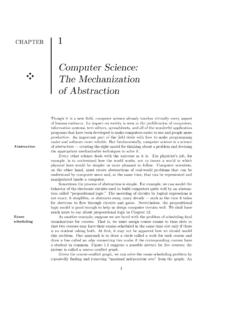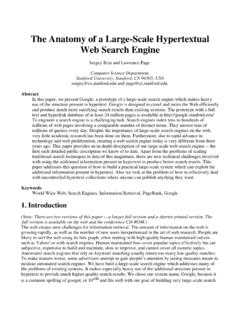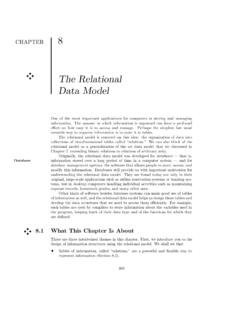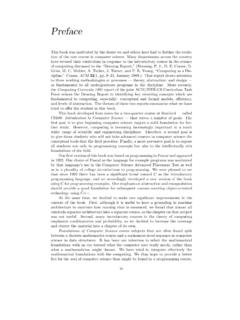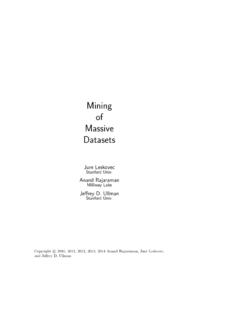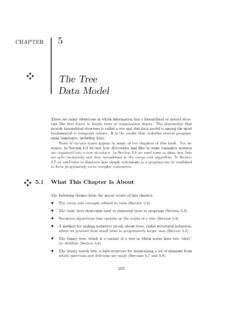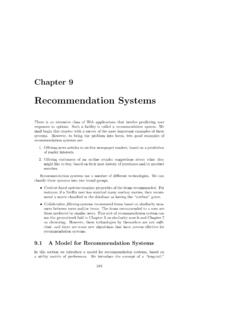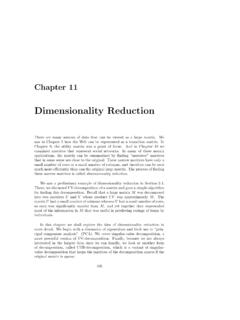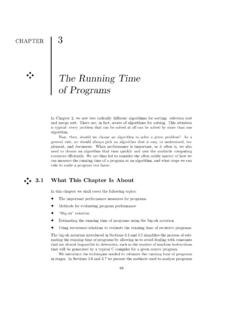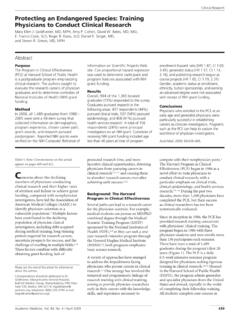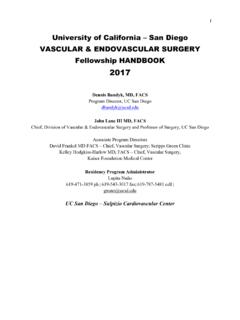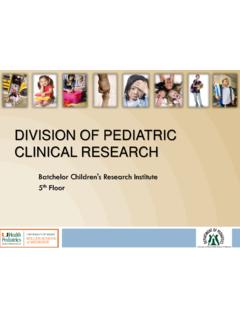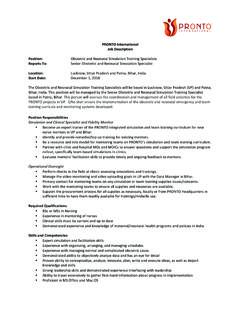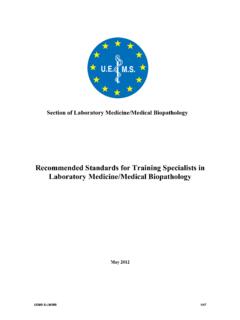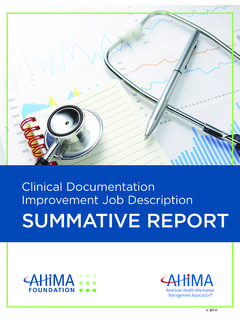Transcription of DATABASES IN HEALTHCARE - Stanford University
1 Stanford Computer Science DepartmentReport No. STAN-CS-80-790 DATABASES IN HEALTHCAREbYGio WiederholdResearch sponsored byNational Institutes of HealthMarch 1980 COMPUTER SCIENCE DEPARTMENTS tanford UniversityDATABASES IN HEALTHCAREGio WiederholdStanford UniversityComputer Science DepartmentMarch 1, 1979CS Report STAN CS80-790 This paper was prepared for a Compendium on Computersin Health Care, Dr. Lindberg, Univ. of Missouri, resources provided by the SUMEX Facility,supported by grant NIH RR-88785 were essential to thepreparation of this document. Some of the work is basedon research carried out as part of the RX project,sponsored by the National Center for Health ServicesResearch under grant no.
2 LR03HS93658. Basic research inDatabase Design leading to some of the concepts presentedhere is supported by ARPA through the KBMS project atStanford IN HEALTHCAREABSTRACTThis report defines database design and implementationtechnology as applicable to HEALTHCARE . The relationship oftechnology to various HEALTHCARE settings is explored, andthe effectiveness on HEALTHCARE costs, quality and access summary of relevant development directions examples of 5 typical applications (public health, clinical trials, clinical research , ambulatory care, and hospitals)are is an extended of the ses and Their in the Area of Data of management systems versus database management Basis for database data of data data into the organization for of DATABASES in Health Care Settings and the Relevancy of database solo Health Care Applications of shared used in HMO' clinical clinical in Future Use of DATABASES in Health Care.
3 Cost-effectiveness issuesInitiatives and innovation due to technology human of in of current interest4 ,4556a91;1213131515171819191919192828212 2222224252627283838i!323334340. The Effect of DATABASES on Health Care Costs, Quality, and Access of the Art of database Technology in Health Care38A. Systems in research or Development Status38B. Industrial database database systems that are applicable to health care 48C. Current Directions of :Examples of Current DATABASES in Health CareA. Public Health :42 CCPDS at the Fred Hutchinson Cancer Center in Seattle42B.
4 Randomized Controlled clinical Trials :ECOG and RTOG at the Harvard Univ. Dept. of Public Health45C. clinical research :TOD and ARAMIS at Stanford University480. HMO Support:COSTAR and the Harvard Community Health Service52E. Hospital Systems :POWS at Coral Gables Variety Childrens54V. References4163wuw 4 DATABASES IN HEALTH CARErrr--~ OF THE TECHNOLOGY ..In this chapter we will introduce the concepts of database technology in away that will make it easy to relate the terminology to problems in the objectives have been defined the major components ofdatabases and their function will be discussed.
5 The remainder of thischapter will present the scientific and the operational issues associatedwith and Their ObjectivesA database is a collection of related data, which are organized so thatuseful information may be effectiveness of databasesderives from the fact that from one single, comprehensive database much ofthe information relevant to a variety of organizational purposes may health care the same database may be used by medIcapersonnel for patient care recording, for surveillance of patient status,and for treatment advice; it may be used by researchers in assessing theeffectiveness of drugs and clinical procedures; and it can be used byadministrative personnel in cost accounting and by management for theplanning of service fact that data are shared promotes consistency of information fordecision-making and duplicate data collection.
6 A major benefitof DATABASES in health care is due to the application of the informationto the management of services and the allocation of resources needed forthose services, but communication through the shared information amonghealth care providers, and the validation of medical care hypotheses fromobservations on patients are also contents and the description of a database has to be carefully managedin order to provide for this wide range of services, so that some degreeof formal data management is implied when we speak of DATABASES .
7 Theformalization, and the large data quantity implied in effective databaseoperations make computerization of the database function essential; in fact,much of the incentive for early [Bush451 and current computing technology[Barsam79) is due to the demands made by information processing , the notion of a database encompasses the data themselves, the hardwareused to store the data, and the software used to manipulate the database is used for multiple purposes we find also an administrationwhich controls and assigns the resources needed to maintain the datacollection and permit the generation of will in the next section define the technical scope of DATABASES .]]
8 Theremaining sections in this chapter will deal specifically with current andfuture applications of DATABASES in health Definitionspage 5 LBTerminology in the Area of Data the scope of DATABASES are a number of concepts, which areeasily confused with each objective of a database is to provideinformation, but not all systems that provide information are will first define the term ' database ',and then some terms that describeaspects of database technology. In the section which follows we will presenttypes of systems which are related or similar to DATABASES , but are notconslderd DATABASES within thls database is a collection of related data,with facilities that process these data toyield database system facilitates the collection, organization, storage, sand processing of processing of data from many sources canprovide information that would not have been available before the datawere combined into a , a collection of data is not byitself a database .
9 A system that supports data storage is not neccessarilya database system,and not all the information provided by computersystems is produced from of databasesA database is hence composed both of data,and of programs or software toenter and manipulate the data and software are stored within thecomputers which support the database ,and the internal organization maynot be obvious to the will now describe some of the componentsthat are part of database require the availability ofcertain technological tools, or software subsystems.
10 Some of these tools,that are used to support DATABASES can also be used independently,and hence they are at times confused with the database system subsystems are:a) File Storage Systems :software to allocate and manage data kept on large computer storage devices, such as disks ) File Access Methods: software to rapidly access and updatedata stored on those ) Data Description Languages: means to describe data so thatusers and machines can refer to data elements and aggregationsof similar data elements conveniently and ) Data Manipulation Languages.

